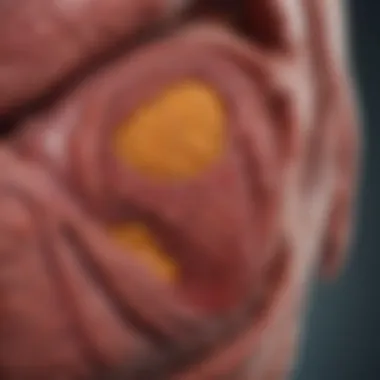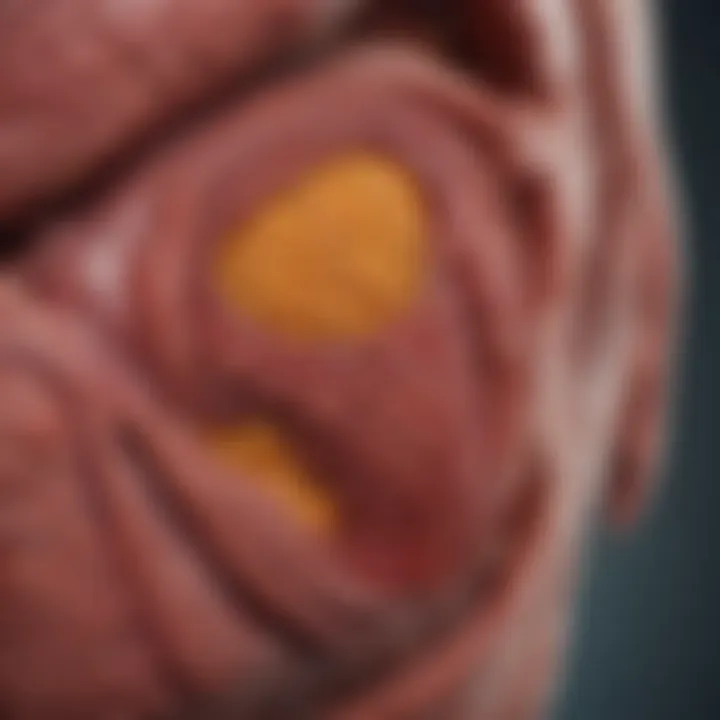Understanding Fatty Liver Disease: Causes and Treatments


Intro
Fatty liver disease has gained increasing attention due to its rising prevalence in populations worldwide. It mainly includes two forms: alcoholic fatty liver disease and non-alcoholic fatty liver disease (NAFLD). Understanding this condition is imperative for both clinicians and the general public, as the implications on health can be severe.
This article aims to shed light on fatty liver disease, exploring its causes, effects, and various treatment options. By addressing the significance of this health issue, we can foster awareness and promote a more proactive approach to prevention and management.
Research Overview
Key Findings
Recent studies indicate that approximately 25% of adults globally are affected by NAFLD. Furthermore, the incidence continues to escalate due to lifestyle changes associated with urbanization and dietary habits. Key findings also emphasize the need for early diagnosis to prevent progression to more severe liver conditions, such as non-alcoholic steatohepatitis (NASH).
Study Methodology
To compile our findings, data from various peer-reviewed journals and health organizations were analyzed. Surveys and observational studies were particularly insightful, providing a strong foundation for understanding the prevalence and effect of fatty liver disease across different demographics. Statistical methods were employed to ensure the reliability and validity of the findings.
Background and Context
Historical Background
The recognition of fatty liver disease dates back several decades. Initially, it was primarily associated with alcohol consumption. However, the emergence of NAFLD illustrates a shift in understanding, showing that non-alcoholic factors can lead to similar liver complications. Today, this condition is recognized as a multifaceted issue involving metabolic syndrome, obesity, and diabetes.
Current Trends in the Field
Current trends indicate a growing body of research focusing on dietary interventions. The Mediterranean diet, for example, has shown promise in improving liver health. Additionally, awareness campaigns aimed at educating the public about the risks of fatty liver disease are increasing in prominence. These efforts are critical in addressing what has become a silent epidemic affecting millions.
"Fatty liver disease is not just a liver problem; it reflects a broader metabolic dysfunction that warrants a multi-disciplinary approach to treatment and prevention."
Preface to Fatty Disease of the Liver
Fatty liver disease is increasingly recognized as a pressing health concern in modern medicine. As the global prevalence of this condition continues to rise, understanding its nature, causes, and consequences becomes essential. This introduction highlights the significance of fatty liver disease, focusing on its growing incidence and potential impact on public health.
The liver plays a crucial role in various metabolic processes, including detoxification, protein synthesis, and the production of biochemicals necessary for digestion. When excess fat accumulates in liver cells beyond the normal limits, it can lead to fatty liver disease. This condition exists in forms such as alcoholic fatty liver disease and non-alcoholic fatty liver disease. Each form has distinct causes and implications, but both can result in severe complications if left untreated.
Importance of Understanding Fatty Liver Disease
Several factors make it imperative to dive deeper into this subject:
- Rising Incidence: Current research indicates a significant increase in both forms of fatty liver disease worldwide. Understanding the underlying causes may provide insight into necessary preventive measures.
- Health Complications: If untreated, fatty liver disease can progress to more severe conditions, including steatohepatitis, cirrhosis, and liver cancer. Highlighting these risks emphasizes the need for early diagnosis and intervention.
- Awareness and Education: Many individuals remain unaware of fatty liver disease, considering it a mild or temporary condition. Increased awareness can lead to better lifestyle choices and prompt medical consultations.
As we continue exploring fatty liver disease, it becomes evident that it is not merely a benign condition. Rather, it poses a substantial risk to overall health and well-being. By understanding its causes, symptoms, and effects, individuals can make informed decisions leading to better health outcomes.
Definition of Fatty Liver Disease
Fatty liver disease refers to the accumulation of excess fat in the liver cells. This condition can occur in individuals who consume alcohol excessively, leading to alcoholic fatty liver disease, or in those who do not drink heavily, resulting in non-alcoholic fatty liver disease. The significance of accurately defining fatty liver disease lies in its rising prevalence and potential complications associated with it.
Understanding fatty liver disease is essential for several reasons. First, it highlights the potential health risks involved. Individuals with fatty liver disease are at an increased risk for developing liver inflammation, fibrosis, and potentially cirrhosis, which can lead to liver failure. Second, the condition is often asymptomatic, making awareness and recognition of its existence vital.
The definition helps in several practical ways:
- Identification: Recognizing fatty liver disease allows for early intervention, which can prevent disease progression.
- Management: A clear understanding aids healthcare practitioners in devising individualized treatment plans.
- Prevention: Awareness can drive lifestyle changes in at-risk populations.
According to recent studies, the understanding of fatty liver disease is evolving, necessitating updated definitions that reflect current knowledge. The complexities of its pathology underscore the need for comprehensive education regarding its implications.
"Fatty liver disease can be a silent threat, necessitating regular check-ups especially for individuals at risk, including those with obesity and metabolic disorders."
Ultimately, effective management strategies are predicated on a thorough understanding of fatty liver disease definitions, allowing for both treatment and preventive measures to be tailored accordingly. This scientific clarity not only empowers patients but also enlightens healthcare professionals to better address this condition in overall medical practice.
Types of Fatty Liver Disease
Understanding the various types of fatty liver disease is crucial for diagnosing, managing, and treating this increasingly prevalent condition. Each type presents its own unique pathophysiology, risk factors, and potential outcomes. Differentiating between these types not only aids healthcare professionals in the formation of an adequate treatment plan but also informs patients about their specific situation. This section covers three main categories: Alcoholic Fatty Liver Disease, Non-Alcoholic Fatty Liver Disease, and Other Specified Fatty Liver Disease.
Alcoholic Fatty Liver Disease
Alcoholic Fatty Liver Disease (AFLD) develops from excessive alcohol consumption, which can lead to fat buildup in liver cells. The degree of fat accumulation in the liver is proportional to the amount and duration of alcohol intake. Early diagnosis is crucial for individuals with AFLD, as the condition can progress to more severe liver injuries if not addressed.
Key Points About AFLD:
- Etiology: The liver metabolizes alcohol, and excessive intake disrupts normal lipid metabolism, promoting fat accumulation.
- Symptoms: Commonly asymptomatic in the early stages, advanced AFLD can present with fatigue, abdominal pain, and jaundice.
- Diagnosis: Typically diagnosed through blood tests, imaging studies, and sometimes liver biopsy.
- Management: The primary treatment involves cessation of alcohol intake and nutritional support.
"Acknowledging the importance of diet and lifestyle changes can lead to significant recovery for patients with AFLD."
Non-Alcoholic Fatty Liver Disease
Non-Alcoholic Fatty Liver Disease (NAFLD) is a more complex condition characterized by the accumulation of fat in the liver in the absence of significant alcohol consumption. NAFLD has become the most common form of liver disease globally, particularly in the context of rising obesity and metabolic syndrome rates. This condition can further progress to Non-Alcoholic Steatohepatitis (NASH), which has more severe implications.
Important Aspects of NAFLD:
- Risk Factors: Includes obesity, type 2 diabetes, and elevated cholesterol levels.
- Subtypes: NAFLD can be classified into simple steatosis and NASH. Simple steatosis is less severe, while NASH involves inflammation and liver damage.
- Diagnosis: Often requires a combination of ultrasound imaging and blood tests to rule out other liver diseases.
- Treatment Options: Lifestyle modifications like diet, exercise, and in some cases, medication may be necessary.
Other Specified Fatty Liver Disease
Other Specified Fatty Liver Disease encompasses various rare and less common liver conditions not classified as AFLD or NAFLD. These can include genetic disorders and conditions induced by certain medications or toxins.


Considerations for Other Specified Conditions:
- Heredity: Certain genetic disorders, such as Wilson’s disease, can lead to fatty accumulation in the liver despite normal alcohol consumption patterns.
- Drug-Induced Factors: Some medications, particularly corticosteroids and certain chemotherapeutic agents, can contribute to fatty liver complications.
- Diagnosis and Treatment: Like other forms, diagnosis typically involves history taking and often imaging or biopsy; treatment focuses on addressing the underlying cause.
Overall, having a detailed understanding of the types of fatty liver disease is essential for improving clinical outcomes. The diversity in causes and implications means that personalized management strategies are necessary, catering to the specific type of fatty liver disease a patient may have.
Epidemiology of Fatty Liver Disease
Understanding the epidemiology of fatty liver disease is crucial for addressing this growing health concern. This aspect of the article provides valuable insights into how widespread the condition is and which populations are most affected. By grasping the prevalence rates and demographic factors, we can better appreciate the impact of fatty liver disease on public health. The examination of these elements is also valuable for healthcare providers, researchers, and policymakers, as it lays the groundwork for informed interventions and preventive strategies.
Global Prevalence Rates
The global prevalence of fatty liver disease has increased significantly over the past few decades. Studies indicate that approximately 25% of adults worldwide are affected by non-alcoholic fatty liver disease (NAFLD). This statistic reflects the growing concerns over obesity and metabolic disorders. The situation is similar with alcoholic fatty liver disease, impacting many individuals dependent on alcohol. The differential rate of occurrence may vary based on geographical regions and lifestyle factors.
Current data supports that the prevalence of fatty liver disease varies among countries. Regions such as North America, parts of Europe, and the Middle East report higher rates compared to Asia and Africa. Factors contributing to these differences include diet, exercise habits, and cultural attitudes towards alcohol consumption.
"As the global obesity epidemic continues, we may witness an increase in liver disease cases tied to its complications".
Demographics at Risk
Certain demographic groups are at a higher risk of developing fatty liver disease. Understanding these demographics is essential for tailoring preventive measures and health interventions. The following groups are particularly vulnerable:
- Individuals with obesity: Excess body weight is one of the strongest risk factors for both NAFLD and alcoholic fatty liver disease.
- Those with metabolic syndrome: Conditions such as type 2 diabetes, hypertension, and dyslipidemia correlate strongly with fatty liver disease.
- Age: The risk increases with age, especially among individuals over 40 years.
- Ethnicity: Specific ethnic groups, including Hispanics, show higher predisposition to fatty liver disease.
- Gender: Men are generally at a greater risk for alcoholic fatty liver disease, whereas women may be more affected by NAFLD.
By recognizing these risk factors and demographic trends, healthcare professionals can prioritize screening and preventive counseling, enabling more effective management of this condition.
Pathophysiology of Fatty Liver Disease
Understanding the pathophysiology of fatty liver disease is critical in addressing this increasingly prevalent health issue. The term refers to the biological and physiological processes that lead to the disease's development. A thorough grasp of these mechanisms aids both researchers and healthcare professionals in devising effective treatment strategies and preventive measures. The understanding of fatty liver disease encompasses several interconnected elements, each contributing to the complex interplay of genetic, environmental, and lifestyle factors.
Lipid Accumulation Mechanisms
Lipid accumulation is a central feature of fatty liver disease. The liver usually maintains a careful balance between lipid uptake, synthesis, and export. However, disturbances in these processes can lead to excessive fat build-up within liver cells—or hepatocytes.
Several factors contribute to this lipid imbalance:
- Increased Fatty Acid Delivery: Factors such as obesity and high dietary fat intake increase the influx of free fatty acids into the liver.
- Decreased Fatty Acid Oxidation: Impaired mitochondrial function and alterations in peroxisome proliferator-activated receptors lead to reduced fatty acid oxidation, worsening lipid accumulation.
- Altered Lipoprotein Production: The liver's ability to export triglycerides in the form of very-low-density lipoprotein (VLDL) can become dysfunctional. This compromised export capacity allows fat to accumulate.
The culmination of these factors results in the liver housing excess lipids, leading to fatty liver disease.
Inflammatory Processes
Chronic inflammation plays a significant role in the progression of fatty liver disease. The presence of excess lipids activates various inflammatory pathways within the liver. Macrophages and other immune cells are recruited to the site, creating an inflammatory microenvironment.
Important aspects to consider include:
- Cytokine Production: Activated immune cells release pro-inflammatory cytokines, such as tumor necrosis factor-alpha (TNF-α) and interleukin-6 (IL-6). These cytokines can damage hepatocytes and promote fibrogenesis.
- Oxidative Stress: Lipid peroxidation due to high lipid levels produces reactive oxygen species (ROS). This oxidative stress inflicts further damage on hepatocytes, perpetuating liver injury.
- Immune Dysregulation: A disrupted immune response can create a cycle of chronic inflammation, which accelerates fibrosis and may eventually lead to cirrhosis.
Understanding these inflammatory processes is key to exploring potential therapies to mitigate liver injury and restore health.
Progression to Steatohepatitis and Cirrhosis
If untreated, fatty liver disease can progress from simple steatosis to non-alcoholic steatohepatitis (NASH), characterized by inflammation and liver cell injury. This progression often leads to more serious liver conditions, including fibrosis and cirrhosis.
Key points regarding this progression include:
- NASH Development: Transition to NASH involves increased liver inflammation and hepatocyte damage. Diagnosing NASH is crucial as it indicates a heightened risk for severe liver complications.
- Fibrosis and Cirrhosis: Continued liver injury triggers the activation of hepatic stellate cells, leading to excessive collagen deposition and fibrogenesis. Eventually, this fibrosis can progress to cirrhosis, significantly impairing liver function.
- Clinical Implications: Individuals with NASH are at a higher risk for developing liver cancer and require close monitoring.
Risk Factors Associated with Fatty Liver Disease
Understanding the risk factors associated with fatty liver disease is crucial for both prevention and management. Identifying these factors enables healthcare providers and patients to target interventions more effectively. The varied nature of risk factors—ranging from lifestyle choices to genetic influences—offers insight into the complexity surrounding this condition. It emphasizes the need for a comprehensive and individualized approach to risk assessment and disease management.
Obesity and Metabolic Syndrome
Obesity stands as a primary risk factor for fatty liver disease. The accumulation of fat in the liver is closely linked to excess body weight. When a person is obese, specific metabolic changes arise, such as insulin resistance. This resistance contributes to higher lipid levels in the bloodstream, facilitating the storage of fat in liver cells.
Metabolic syndrome encompasses several disorders, including hypertension, dyslipidemia, and hyperglycemia. Individuals with metabolic syndrome often face heightened risks for non-alcoholic fatty liver disease (NAFLD).
Research indicates that approximately 70-90% of individuals with obesity may have some form of fatty liver disease.
This statistic underscores the urgent need for effective obesity management strategies, including:
- Nutritional interventions
- Regular physical activity
- Behavioral therapies
When these components are addressed, patients may witness a significant improvement in liver function and overall metabolic health.
Dietary Factors
Diet plays a pivotal role in the development of fatty liver disease. High-calorie diets, especially those rich in carbohydrates, fats, and sugars, can lead to fat accumulation in the liver. Processed foods often contain trans fats and high fructose corn syrup—both linked to liver inflammation. Moreover, diets low in fiber can hinder the body's ability to manage lipid levels effectively.
Strategies to adjust dietary habits can include:
- Increasing intake of whole grains
- Incorporating more fruits and vegetables
- Reducing consumption of processed foods


Studies indicate a diet like the Mediterranean diet, focusing on healthy fats and lean proteins, may reduce the risk of fatty liver disease. By recognizing these dietary connections, individuals can make informed choices that directly impact their liver health.
Genetic Predispositions
Genetics also plays an essential role in the susceptibility to fatty liver disease. Certain genetic variants can affect how individuals metabolize fats, leading to increased liver fat accumulation. Family history is a vital consideration when assessing risk.
Some specific genes linked to the development of fatty liver disease include:
- PNPLA3: Variants in this gene are associated with higher liver fat content and an increased risk of NAFLD.
- TM6SF2: This gene influences the lipid metabolism and has been correlated with an elevated risk for more severe liver damage.
These genetic factors are indicative of a person's risk profile but do not determine fate. Monitoring lifestyle choices can mitigate their effects. Regular consultations with healthcare professionals, especially for those with a family history, can provide guided interventions suited for individual genetic backgrounds.
Diagnosis of Fatty Liver Disease
Diagnosing fatty liver disease is crucial for effective management and treatment of the condition. Early detection can prevent progression to more severe liver issues, such as cirrhosis and liver failure. The diagnosis typically involves a combination of clinical assessment, imaging techniques, and sometimes liver biopsy, each providing unique insights into liver health. Understanding these diagnostic approaches helps in identifying individuals at risk and addressing the disease appropriately.
Clinical Assessment
A clinical assessment is often the first step in diagnosing fatty liver disease. Physicians look for specific signs and symptoms during a patient’s visit. Common symptoms might include fatigue, weakness, and discomfort in the upper right abdomen, but many patients remain asymptomatic. Therefore, a thorough medical history and physical examination are essential.
The assessment also involves reviewing risk factors such as obesity, diabetes, and alcohol consumption. Healthcare professionals may also screen for metabolic syndrome. This multi-faceted evaluation plays an important role in recognizing potential fatty liver cases, allowing for timely intervention.
In some situations, blood tests are performed. Elevated liver enzymes can indicate liver inflammation, which may suggest the presence of fatty liver disease. However, these tests alone cannot confirm the diagnosis, making further investigation necessary.
Imaging Techniques
Imaging techniques are vital in diagnosing fatty liver disease. These non-invasive methods help visualize the liver and assess the degree of fat accumulation. Common imaging modalities include ultrasound, computed tomography (CT), and magnetic resonance imaging (MRI).
Ultrasound is the most widely used initial imaging technique due to its accessibility and cost-effectiveness. It can reveal increased echogenicity, indicating fat in the liver.
CT scans provide more detailed images and can quantify the extent of fat depositions, while MRI can offer high-resolution images without radiation exposure. However, MRI is often more expensive and less accessible.
These imaging methods are crucial as they guide clinicians not only in confirming the diagnosis but also in determining the severity of the disease, which influences management strategies.
Liver Biopsy Considerations
Liver biopsy may be considered in some cases where there is uncertainty regarding the diagnosis or to assess liver damage. This procedure involves taking a small tissue sample from the liver for microscopic examination. Considering a liver biopsy comes with certain risks and is usually not the first line of investigation due to its invasiveness.
Indications for a biopsy include:
- Persistent elevated liver enzymes despite changes in lifestyle or treatment.
- Assessment of liver fibrosis or cirrhosis.
- Evaluation of uncertain diagnoses from imaging studies.
The results from a biopsy can provide detailed information about the degree of steatosis and any associated inflammation or fibrosis. This information is essential for making informed clinical decisions regarding treatment and management.
In summary, the diagnosis of fatty liver disease is a multi-step process that combines clinical assessment, imaging techniques, and potentially liver biopsy. Each element offers valuable insights that contribute to a comprehensive understanding of liver health.
Symptoms of Fatty Liver Disease
Understanding the symptoms of fatty liver disease is central to recognizing its presence and determining the urgency of medical intervention. This aspect serves as a critical element in the broader narrative of liver health and diseases. Many people diagnosed with fatty liver disease might remain unaware of their condition due to its often silent nature.
Common Clinical Manifestations
When symptoms do manifest, they can vary significantly among individuals. The most commonly reported clinical manifestations include:
- Fatigue: A general sense of exhaustion is often reported, affecting daily function and overall quality of life.
- Abdominal discomfort: Patients may experience pain or discomfort in the upper right quadrant of the abdomen.
- Weight loss: Unexplained weight loss can sometimes be a warning sign, as the body struggles to manage fatty deposits.
- Elevated liver enzymes: Routine blood tests may reveal elevated levels of liver enzymes, indicating liver inflammation or damage.
Notably, these symptoms can often overlap with other conditions, making definitive diagnosis challenging. Therefore, an awareness of these manifestations is paramount for early detection and treatment.
Asymptomatic Cases
Perhaps one of the most crucial points in understanding fatty liver disease is the prevalence of asymptomatic cases. Many individuals may carry the disease without exhibiting any noticeable symptoms. This lack of overt clinical signs can lead to delayed diagnosis and treatment, increasing the risk of severe complications, such as cirrhosis or liver failure.
A significant aspect about asymptomatic cases is the need for routine screenings, especially among high-risk populations. Regular health check-ups may uncover abnormal liver function tests that would otherwise go unnoticed.
"Early identification in asymptomatic individuals can significantly alter disease trajectory."
This aspect is especially critical for individuals with risk factors such as obesity, metabolic syndrome, or excessive alcohol consumption.
Consequences of Untreated Fatty Liver Disease
Untreated fatty liver disease can lead to serious health complications. Understanding these consequences is essential for awareness and prevention. Awareness ensures diagnosis and management can occur before severe outcomes manifest. When fatty liver disease progresses unchecked, various degrees of liver damage can occur, significantly influencing overall health.
Progression to Cirrhosis
Cirrhosis is a late-stage damage that affects the liver's structure. This process develops silently over years. Initially, the liver tries to heal itself from fat buildup but continual insult leads to inflammation and fibrosis. Persistent fatty liver disease can result in scarring, eventually culminating in cirrhosis. This condition disrupts normal liver function and leads to complications such as portal hypertension and liver cancer.
Cirrhosis often presents itself with minimal symptoms until significant damage is done. Patients may not realize they are at risk until they experience severe signs, such as jaundice or swelling in the abdomen. Those with fatty liver, especially non-alcoholic fatty liver disease, are at increased risk of developing cirrhosis.
Liver Failure Risks
Liver failure is the ultimate end-stage consequence of untreated fatty liver disease. This condition occurs when the liver loses its ability to function adequately. Risk factors related to fatty liver disease, especially cirrhosis, directly contribute to this outcome. When the liver fails, the body's balance and functions are severely compromised. This may include problems with digestion, detoxification, and metabolism.
Liver failure can manifest in two types: acute and chronic. Acute liver failure can occur rapidly, even in individuals with no previous liver disease. In contrast, chronic liver failure develops gradually, often as a result of organ damage due to prolonged fatty liver disease.


According to recent studies, approximately 30% of individuals with cirrhosis due to fatty liver progress to liver failure within ten years. This statistic illuminates the critical need for timely intervention and management of fatty liver disease.
Management of Fatty Liver Disease
Managing fatty liver disease is critical to mitigating its effects on health and preventing complications. This management encompasses a blend of lifestyle changes, pharmacological approaches, and, in severe cases, surgical interventions. Understanding these strategies is essential for healthcare providers and patients alike, enabling proactive and informed decisions regarding treatment plans.
Lifestyle Modifications
Lifestyle modifications serve as the cornerstone of addressing fatty liver disease. These adjustments primarily revolve around diet and exercise. Here are some key recommendations:
- Balanced Diet: A diet rich in whole foods, including fruits, vegetables, whole grains, and lean proteins, can significantly help liver health. Reducing intake of saturated fats, refined carbohydrates, and sugars is essential.
- Weight Loss: For individuals with obesity, gradual weight loss (about 5-10% of body weight) can reduce liver fat. Even modest weight loss can lead to significant improvements.
- Physical Activity: Regular exercise, such as walking, swimming, or cycling, is beneficial. Aim for at least 150 minutes of moderate-intensity aerobic activity per week.
- Avoid Alcohol: Though not all fatty liver conditions are related to alcohol, it’s wise to limit consumption for conspicuous benefits.
Increased awareness of these modifications can lead to meaningful improvements in liver function and overall health.
Pharmacological Interventions
Pharmacological interventions may become necessary when lifestyle changes alone do not yield desired outcomes. Currently, no specific medications are approved solely for treating fatty liver disease, but several options can assist in managing associated conditions:
- Insulin Sensitizers: Drugs such as pioglitazone may improve liver histology and insulin sensitivity. These are particularly useful for individuals with insulin resistance or type 2 diabetes.
- Vitamin E: The antioxidant vitamin E has shown promise in clinical trials for non-alcoholic fatty liver disease, improving liver function tests and histological outcomes in some patients.
- Lipid-Lowering Agents: Statins might be prescribed to manage dyslipidemia often seen in fatty liver patients. They can improve overall cardiovascular health, indirectly aiding liver health.
It is essential for healthcare providers to carefully evaluate the potential benefits and side effects of these medications when prescribing treatment.
Surgical Options
In extreme cases, where fatty liver disease has progressed significantly, surgical options may be considered. Surgery is typically reserved for cases of severe non-alcoholic steatohepatitis (NASH) that have progressed to advanced liver disease.
- Liver Transplantation: This is a viable option for individuals with irreversible liver damage. A successful transplant can restore health but requires careful assessment and selection criteria.
- Bariatric Surgery: For morbidly obese patients, bariatric surgery can lead to significant weight loss, which may dramatically improve liver condition. Studies indicate that many patients experience regression of fatty liver after surgery.
The decision to pursue surgical options should align with a comprehensive evaluation by a specialized medical team, considering both risks and potential outcomes.
Ultimately, tailored management plans based on individual needs and conditions play a crucial role in addressing fatty liver disease.
Preventive Measures for Fatty Liver Disease
Preventive measures for fatty liver disease play an essential role in mitigating the risk and progression of this condition. The rising prevalence of fatty liver disease highlights the urgent need for effective strategies aimed at prevention. These measures not only focus on lifestyle changes but also promote awareness of the disease, understanding its risk factors, and encouraging regular health screenings. Implementing preventive measures can significantly reduce the incidence of fatty liver disease and its associated complications.
Dietary Recommendations
Dietary recommendations form the cornerstone of preventive measures against fatty liver disease. A diet rich in whole foods can aid liver health significantly. It is crucial to focus on whole grains, lean proteins, healthy fats, and plenty of fruits and vegetables. Some specific dietary changes to consider include:
- Reduce sugar intake: High fructose consumption from sugary beverages and snacks can lead to increased fat accumulation in the liver.
- Limit saturated fats: These fats, often found in processed foods, red meat, and full-fat dairy, should be minimized to lower liver fat levels.
- Increase fiber intake: Foods high in fiber, such as legumes, nuts, and whole grains, can enhance gut health and help control weight, thus benefitting liver function.
- Prioritize omega-3 fatty acids: Foods containing omega-3, like fatty fish, can potentially reduce liver fat and improve overall liver function.
Creating a balanced meal plan may be beneficial. Regular meal patterns reduce the risk of overeating or binge eating, which can contribute to liver issues. Overall, emphasizing a clean, nutrient-dense diet is vital for preventing fatty liver disease.
Physical Activity Guidelines
In addition to dietary changes, physical activity is crucial in preventing fatty liver disease. Regular exercise aids in maintaining a healthy weight and improving metabolic health. Engaging in consistent physical activity helps in several ways:
- Burns calories: Regular workouts assist in weight management. Reducing body weight by even a small percentage can significantly improve liver health.
- Improves insulin sensitivity: Increased physical activity can help maintain balanced blood sugar levels, reducing the risk of non-alcoholic fatty liver disease.
- Enhances overall well-being: Physical fitness promotes overall health, reducing stress and enhancing mood, which can indirectly support healthy habits.
It is recommended to engage in at least minutes of moderate aerobic activity, such as brisk walking, each week. For those looking to lose weight or maintain weight loss, more vigorous exercise may be necessary.
Adopting preventive measures can have a profound impact on liver health and overall quality of life. Knowing the simple steps to reduce risk is key in combatting fatty liver disease.
Adhering to these guidelines can lay a strong foundation for liver health and significantly contribute to preventing the onset of fatty liver disease. Understanding that prevention is always more manageable than treatment reinforces the importance of adopting a healthy lifestyle. Continuous education around these preventive strategies remains vital to empower individuals to take control of their liver health.
Future Directions in Research
Research into fatty liver disease is essential for advancing our understanding and treatment of this growing health concern. As more individuals are diagnosed with various forms of fatty liver disease, including both alcoholic and non-alcoholic cases, the need for innovative therapeutic strategies increases. Future research can illuminate areas that remain poorly understood, paving the way for effective interventions and improved patient outcomes.
Emerging Therapeutics
Emerging therapeutics represent a crucial focus area in the fight against fatty liver disease. Recent developments have introduced several potential treatment options which include novel medications that target underlying mechanisms of lipid accumulation and inflammation. Studies on compounds like obeticholic acid and elafibranor show promise in their ability to improve liver function and reduce fat content. These medications aim to alter metabolic pathways that contribute to hepatic steatosis and subsequent complications.
In addition to pharmacological therapies, alternative approaches such as gene editing and regenerative medicine are gaining traction. Techniques like CRISPR-Cas9 hold potential for correcting genetic anomalies contributing to fatty liver disease. This innovative technology may one day offer personalized treatment options tailored to individual patients’ genetic backgrounds, thereby increasing efficacy.
Longitudinal Studies and Their Importance
Longitudinal studies provide invaluable insights into the progression of fatty liver disease over time. By tracking patients over extended periods, researchers can identify risk factors, patterns of disease progression, and responses to treatment. These observational studies are essential for establishing causal relationships and understanding the long-term effects of various interventions.
The importance of longitudinal research cannot be overstated. It allows scientists to capture the nuanced interactions between various environmental and genetic factors that influence disease outcomes. Additionally, such studies help in assessing the effectiveness of emerging treatments by providing data on sustained changes in liver histology and function.
The End
The exploration of fatty liver disease encompasses various dimensions essential for understanding its implications on health. Recognizing the severity of this condition is imperative as it represents a growing epidemic affecting millions worldwide. This section serves to synthesize the information discussed throughout the article, reinforcing the importance of awareness, preventive measures, and treatment options.
Fatty liver disease can lead to serious complications, including cirrhosis and liver failure. Therefore, understanding its causes and effects is crucial for individuals, healthcare providers, and policymakers alike. The knowledge gained from the previous sections can help individuals identify risk factors and make informed decisions about lifestyle alterations, dietary habits, and monitoring their liver health.
Moreover, acknowledging the connections between fatty liver disease and underlying health conditions, such as obesity and metabolic syndrome, emphasizes the need for an integrated approach to treatment. Interventions must not only address liver health but also broader metabolic factors contributing to the disease.
"Awareness and understanding of fatty liver disease are the first steps toward a healthier future."
As research continues to evolve, the identification of new therapeutics and longitudinal studies will enhance our comprehension of this condition. The insights gained will be vital for developing more effective treatment strategies that cater to the individual needs of patients.
Benefits of a Strong Reference List
- Credibility: Use of peer-reviewed articles and recognized medical journals.
- Accessibility: Links to open-access journals enhance reach for those without subscriptions.
- Depth: Inclusion of various types of studies, including clinical trials, meta-analyses, and reviews.
"A strong reference section is not just an appendix; it is a gateway to deeper understanding and ongoing learning."
By providing references, this article invites readers to explore beyond the text, encouraging an investigative approach to learning about fatty liver disease. This not only broadens their knowledge but also fosters a sense of responsibility to stay informed about health topics that impact many lives globally.





